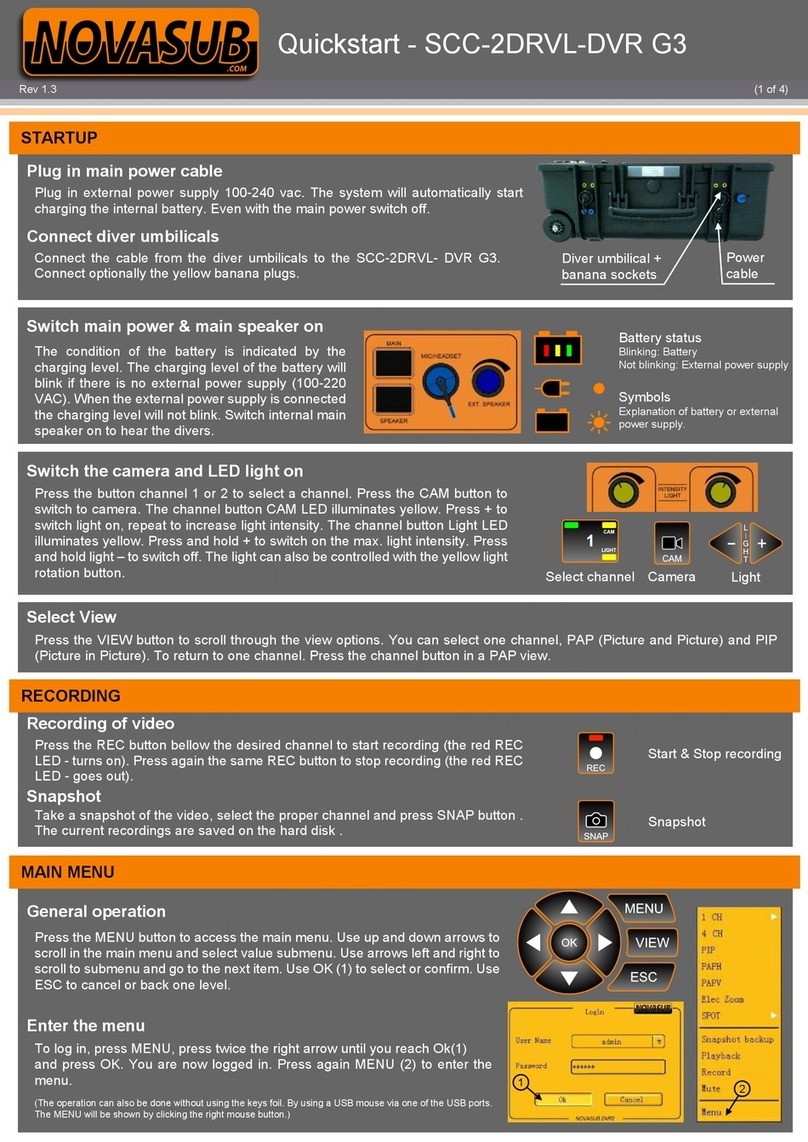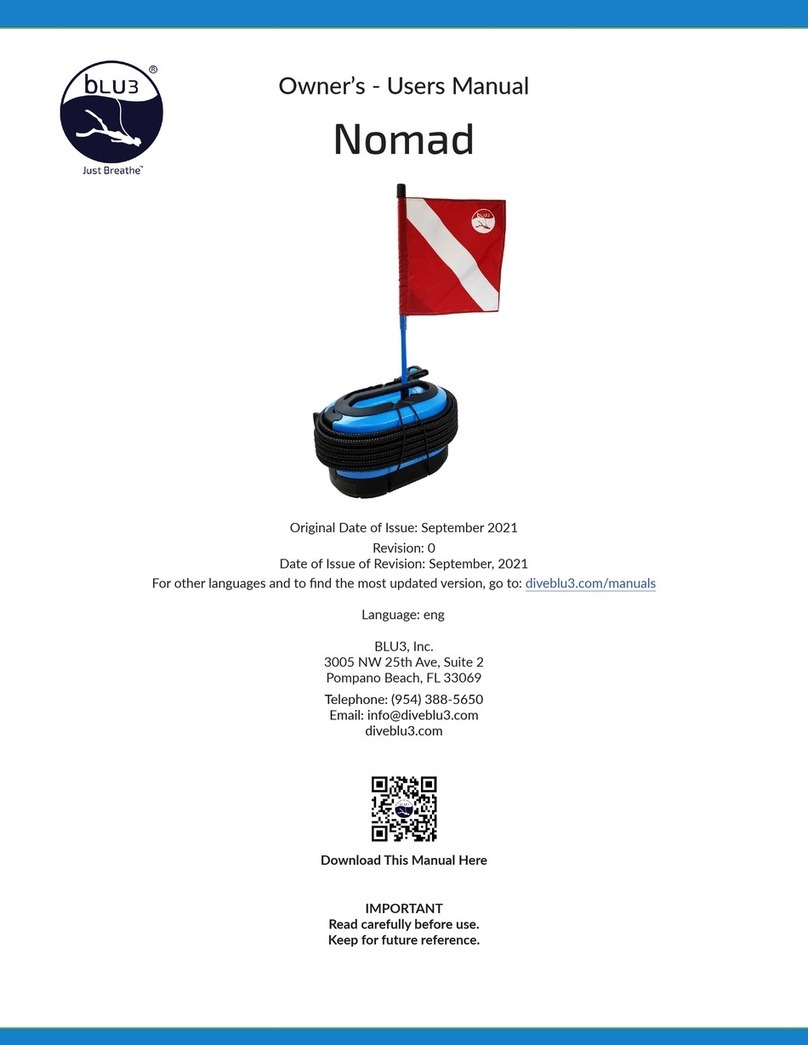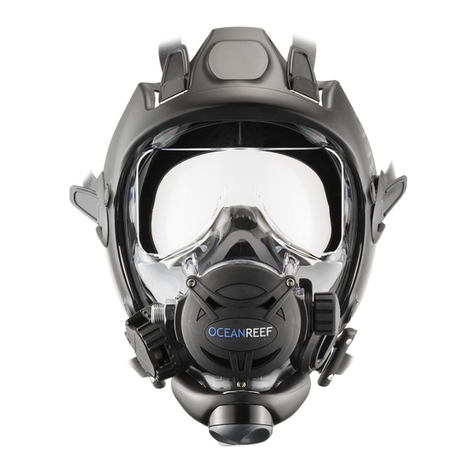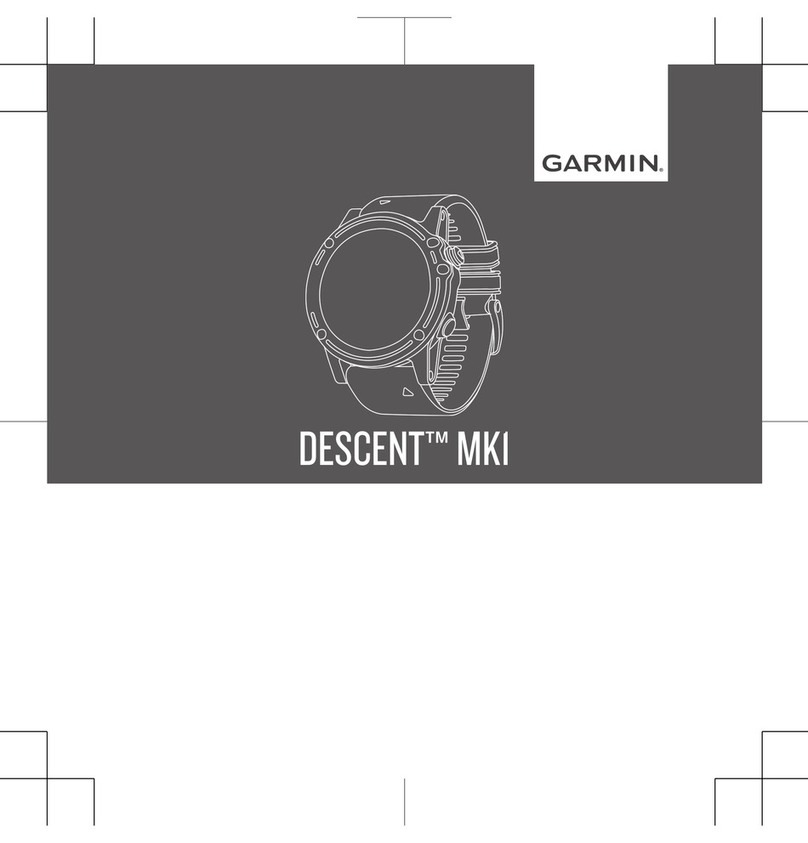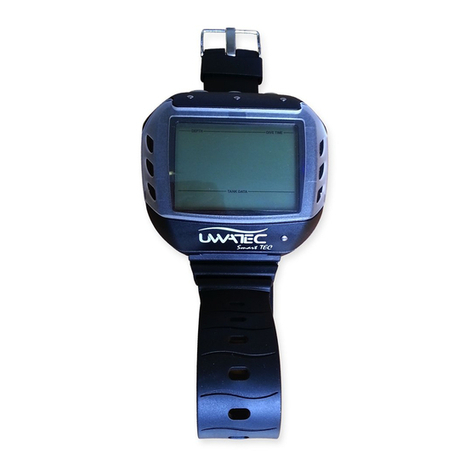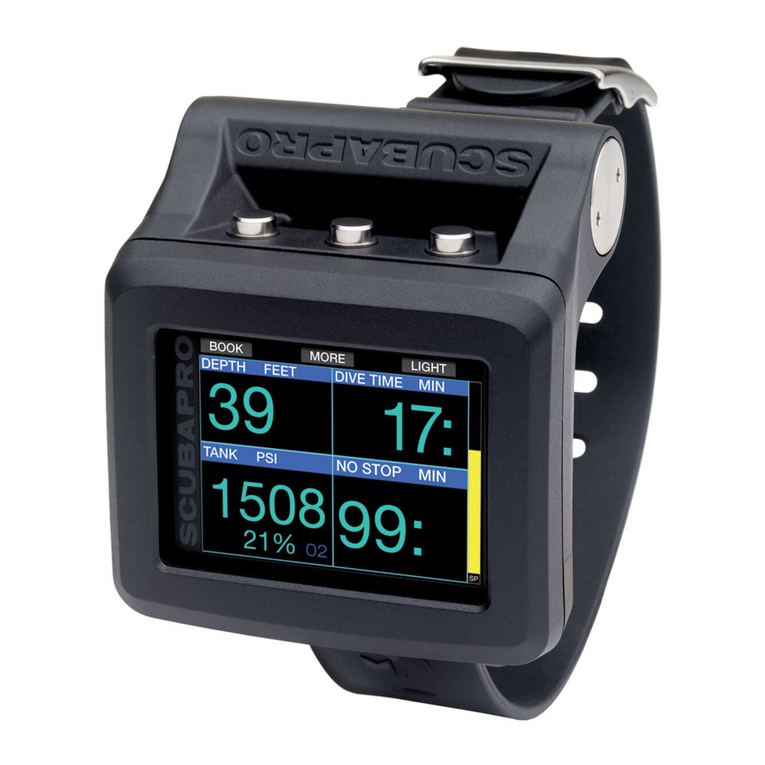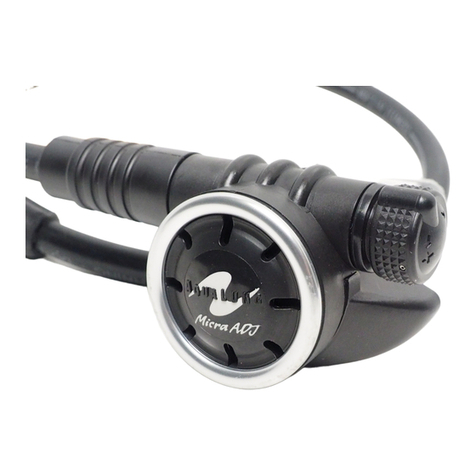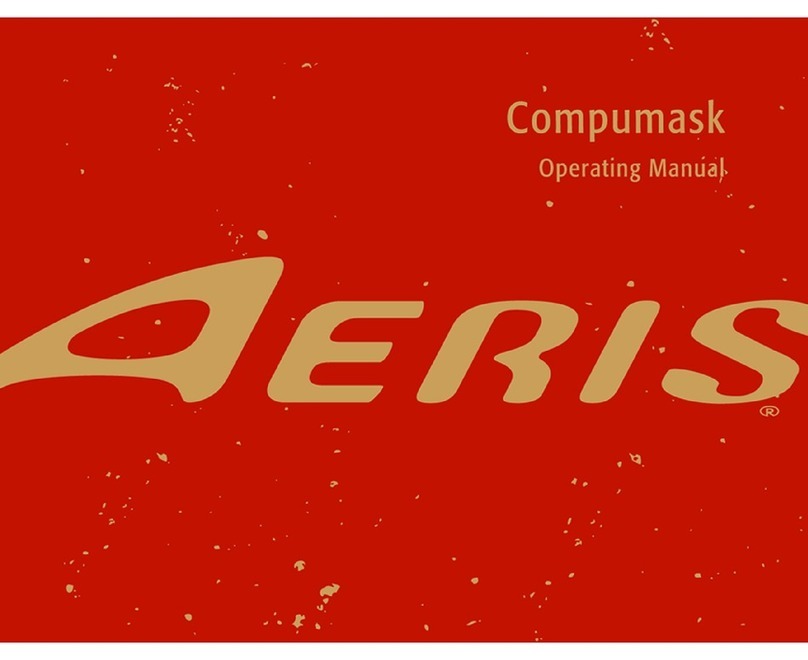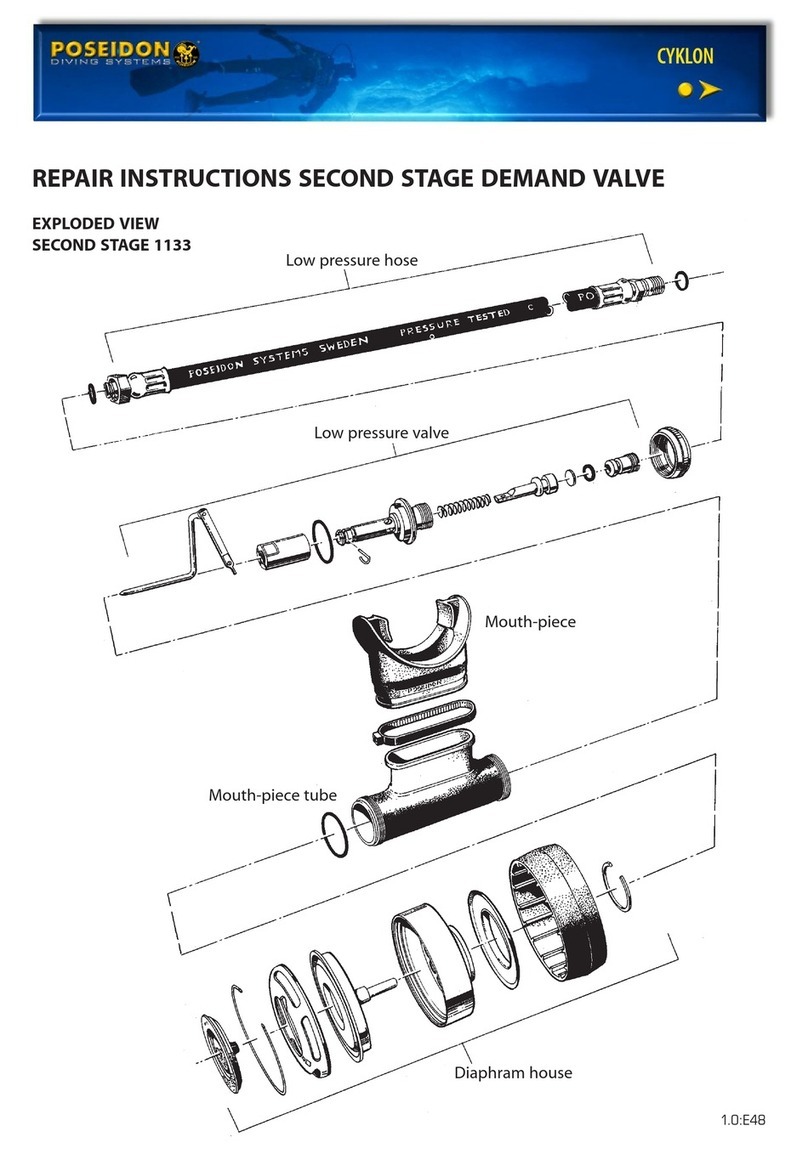TecLINE R2 TEC User manual

SCUBATECH
USER MANUAL
Demand regulators
Range of models
R2 TEC, R2 TEC O2, R2 TEC INT, R4 TEC
R4 TEC O2, R4 TEC INT, R5 TEC, V1 ICE
V1 ICE INT, V2 ICE, R1 PRO, R1 PRO O2
R1 PRO INT
REC1, REC1 O2, REC1 OCTO
TEC1, TEC1 O2, TEC1 OCTO
TEC2, TEC2 O2, TEC2 OCTO
Issue 2021/3

Page 2 / 15
Table of contents:
1. Introduction
2. Important warnings
3. Design and basic technical data
4. Intended use
5. Using with nitrox mixture and oxygen
6. Using in cold water
7. Preparing for use
8. The use during diving
9. The use after diving, maintenance and storage
10. Warranty
11. Manufacturer information
12. Notes
Copyright information
These instructions are protected by copyright. All rights reserved. Copying,
reproduction, translation or saving in any electronic medium in whole or in part
without a written consent of Scubatech is forbidden.
Demand Regulator User Manual
Series models – R2 TEC, R2 TEC O2, R2 TEC INT, R4 TEC, R4 TEC O2, R 4 TEC INT
R5 TEC, V1 ICE, V1 ICE INT, V2 ICE, R1 PRO, R1 PRO O2, R1 PRO INT
REC1, REC1 O2, REC1 OCTO, TEC1, TEC1 O2, TEC1 OCTO, TEC2,
TEC2 O2, TEC2 OCTO
©2021 Scubatech Ltd.

Page 3 / 15
Congratulations on the purchase of Scubatech / Tecline demand regulator.
We would like to thank for your choice and wish you many exciting dives!
1. Introduction
Before the first use of Scubatech / Tecline demand regulators you should read
carefully and understand all information presented in this user manual. Please read,
understand and conform to these instructions to use the products presented in this
manual in a safe manner and for many years.
We recommend keeping this user manual for the whole period of using the product.
Scubatech / Tecline demand regulators may be used only in the way presented in
this user manual.
Scubatech / Tecline demand regulator is a precise device. It must be used with care
due to its essential function performed during diving. The guidelines contained in this
manual must be followed to ensure the best efficiency and service life of this
regulator.
Scubatech / Tecline shall not be liable for damages caused by non-compliance with
the instructions contained in this manual.
2. Important warnings
CAUTION
Diving is a potentially hazardous activity. The demand regulator's instructions
for use shall not be a substitute of professional diving training carried out by a
qualified instructor.
All demand regulators described in this manual were certified by the body notified by
Polski Rejestr Statków S.A. (Polish Register of Shipping)
and they conform to the requirements of Regulation (EU) 2016/425 of the European
Parliament and of the Council of 9 March 2016 on personal protective equipment and
repealing Council Directive 89/686/EEC and the standard PN-EN 250:2014-08 -
Respiratory equipment — Open-circuit self-contained compressed air diving
apparatus - Requirements, testing, marking. The CE mark denotes conformity to the
requirements and the number 1463 next to the CE mark is an identification code of
the Polish Register of Shipping.
CAUTION
In the non-member states of European Union, additional requirements
regarding the use of demand regulators may apply. Before using Scubatech /
Tecline products, please check current requirements that are effective in the
country where you intend to use them.
CAUTION
The content of these instructions is based on knowledge available upon its
release for printing. Scubatech / Tecline reserves the right to make
modifications in any time.

Page 4 / 15
CAUTION
Demand regulators were tested for conformity to the requirements of the
standard EN 250:2014-08. Demand regulators can be used as an escape device
by more than one diver at the same time:
- in water temperature higher than 10oC (pressure reducers R1 PRO, R1 PRO
O2, R1 PRO INT and demand regulators REC1, REC1 OCTO, REC1 O2;
- in water temperature higher than 4oC (pressure reducers R2 TEC, R2 TEC O2,
R2 TEC INT, R4 TEC, R4 TEC O2, R4 TEC INT, R5 TEC, V1 ICE, V1 ICE INT, V2
ICE and demand regulators TEC1, TEC1 OCTO, TEC1 O2, TEC2, TEC2 OCTO,
TEC2 O2).
CAUTION
If SCUBA is configured for and used by more than one diver at the same time,
then it shall not be used at depths greater than 30 m and:
- in water temperature lower or equal to 10oC (pressure reducers R1 PRO, R1
PRO O2, R1 PRO INT and demand regulators REC1, REC1 OCTO, REC1 O2);
- in water temperature lower or equal to 4oC (pressure reducers R2 TEC, R2
TEC O2, R2 TEC INT, R4 TEC, R4 TEC O2, R4 TEC INT, R5 TEC, V1 ICE, V1 ICE
INT, V2 ICE and demand regulators TEC1, TEC1 OCTO, TEC1 O2, TEC2, TEC2
OCTO, TEC2 O2).
CAUTION
Scubatech / Tecline demand regulators may be used only with diving cylinders
holding verification certificates compliant with current requirements applicable
in the country where you intend to use them.
CAUTION
Scubatech / Tecline demand regulators may be supplied only with the gas
compliant with the requirements of the standard PN-EN 12021. If moisture
accumulates in the diving cylinder, it may cause possible cylinder corrosion as
well as freezing and malfunctioning of the regulator when diving at low
temperatures (below 10°C (50°F)). Diving cylinders should be transported in
compliance with local regulations for transport of hazardous products. The use
of a cylinder is subject to gas and compressed air use regulations.
CAUTION
Please note that deep diving increases the risk of decompression sickness and
other diving sicknesses. Generally, diving below the depth of 40m or
decompression diving is not recommended. If you wish to do deep diving, you
must have special training and equipment configured for this type of diving.
Scubatech / Tecline demand regulators ensure reliable operation up to the
depth of 50m. Nonetheless, divers must conform to the limits prescribed by the
local regulations that are effective at the place of diving

Page 5 / 15
3. Design and basic technical data
Scubatech / Tecline demand regulators are two-staged diving regulators with
pressure reduction stages separated by an interstage hose. They are composed of a
first-stage pressure reduction (pressure reducer), interstage hose and a second-
stage pressure reduction (diving regulator).
The first pressure reduction stages of demand regulators are pressure relief valves.
They are equipped with 2 or 4 reduced pressure ports marked with the letters LP and
1 or 2 high-pressure ports marked with the HP letters. The HP ports have larger
diameter than medium pressure ports. The first pressure reduction stages of
Scubatech / Tecline demand regulators (only models: R2 TEC, R2 TEC O2, R2 TEC
INT, R4 TEC, R4 TEC O2, R4 TEC INT, R5 TEC, V1 ICE, V1 ICE INT, V2 ICE) are
equipped with diaphragm, which protects operating environment of the high-pressure
valve and other valve components against external conditions. This solution allows
for using the valve in extreme conditions and the regulator is also designed for use by
advanced divers. Other first pressure reduction stages of Scubatech / Tecline
demand regulators (only models: R1 PRO, R1 PRO O2, R1 PRO INT) are piston
pressure reducers with wet chamber which make the construction light and simple.
The main task of the first pressure reduction stages of demand regulators is to
reduce pressure in a diving cylinder (or set of cylinders) to the pressure value that
corresponds to the total pressure of ambient pressure (hydrostatic pressure variable
depending on depth) and constant overpressure of 9-10 bar.
Figure 1. The first stages of pressure reduction of demand regulators

Page 6 / 15
The second pressure reduction stages of Scubatech / Tecline demand regulators are
based on a standard relief pressure reducing system. They are equipped with a
Venturi nozzle with a setpoint adjusted by a diver that allows delivery of maximum
flow of breathing gases. Using an adjustable deflector that directs appropriately the
breathing gas flow in combination with the Venturi nozzle substantially reduces the
breathing resistance.
In addition to adjustment of the Venturi Effect, the second pressure reduction stages
of Scubatech / Tecline demand regulators (only models: TEC1, TEC1 OCTO, TEC1
O2, TEC2, TEC2 OCTO and TEC2 O2 are equipped with a breathing resistance
adjustment knob located on the opposite side of the interstage hose of the diving
regulator's box. When the knob is set in a closed position, taking a breath requires
more effort and the diving regulator is less sensitive to sudden changes of pressure.
Breathing is easier when the knob is twisted off, as it requires less effort to take a
breath. Adjustment is smooth and you can set the knob in the position that suits you
best. When storing a diving regulator equipped with a breathing resistance
adjustment knob, the knob should be set in an open position.
Figure 2. The second stages of pressure reduction of demand regulators
Interstage hose is a medium pressure hose of operating pressure 17 bar. Hose
connections of the demand regulators are made of high quality materials.

Page 7 / 15
Basic technical data:
Depth of parameters tested - 50m
Maximum supply pressure - 300 bar (232 bar INT (Yoke) connections)
Reduced pressure - 9.0 – 10 bar
Threads:
Valve connection: - DIN 5/8”
- INT (Yoke)
High pressure plug - 7/16” (number depends on a model)
Medium pressure plug - 3/8” (number depends on a model)
4. Intended use
Demand regulators presented in this manual are diving gas regulators used for
recreational and professional diving. Demand regulators are used with a single diving
cylinder or twinset of operating pressure up to 30 MPa (300 bar).
CAUTION
Scubatech / Tecline shall not assume responsibility for malfunctioning of
demand regulators if they have been used contrary to their purpose, if
unoriginal spare parts have been used or if they have been serviced by a
person not authorised by Scubatech / Tecline.
5. Using with nitrox
IMPORTANT
Important information regarding the use of demand regulators with nitrox
mixtures is described below.
CAUTION
Diving with the use of nitrox mixtures requires completion of a specialist
training. Diving with the use of nitrox mixtures without specific knowledge and
skills may lead to serious health problems or death.
CAUTION
Diving with the use of nitrox mixtures requires application of specific
equipment and procedures that differ from those required by a user of
standard compressed air.
Using demand regulators with nitrox mixtures outside the EU (European
Union).
Standard Scubatech / Tecline demand regulators sold to non-member EU countries
are produced with the application of materials, assembly procedures and greases
that ensure compatibility with nitrox mixtures of the maximum oxygen content of 40
%.

Page 8 / 15
CAUTION
If before using with nitrox mixtures a demand regulator was used with standard
compressed gas, it is recommended to carry out a proper maintenance
procedure. An Authorized Scubatech / Tecline Service Technician should
provide all required information about this subject.
Using demand regulators with nitrox mixtures in the EU (European
Union) countries.
Scubatech / Tecline offers additional models of demand regulators specially
prepared for use with nitrox mixtures of oxygen content over 21%, including the use
of pure oxygen. The above products were tested in accordance with PN-EN 144-
3:2005 standards Respiratory protective devices - Gas cylinder valves - Part 3:
Outlet Connections for diving gases nitrox and oxygen and PN-EN 13949:2005
Respiratory equipment - Open-circuit self-contained diving apparatus for use with
compressed nitrox and oxygen - Requirements, testing, marking.
Please contact an Authorised Scubatech / Tecline Dealer to receive more information
regarding these models.
6. Using in cold water
CAUTION
Cold water diving requires completion of a specialist training.
In accordance with European CE EN standardization, the temperature of cold water
is 10°C or lower. In such conditions, particularly in fresh water that has higher
freezing point, the risk of freezing of a pressure reducing valve or diving regulator is
high. The usual effects include a constant outflow of breathing gases, and their
quicker loss as a result. The lower the ambient temperature is, the higher the risk of
the above described situation is.
Demand regulators operating at low temperatures must be properly protected. Dry
chamber used in pressure reducers R2 TEC, R2 TEC O2, R2 TEC INT, R4 TEC, R4
TEC O2, R4 TEC INT, R5 TEC, V1 ICE, V1 ICE INT, V2 ICE substantially decreases
the risk of freezing. It is also highly recommended to use the above systems in
pressure reducing valves used for diving at the depth below 30m.
To reduce the risk of freezing of a demand regulator, it is necessary to:
avoid releasing breathing gases on the surface and underwater at the air
temperatures around 0°C and below,
not allowing for a free-flow of a diving regulator,
avoid simultaneous inflation of a buoyancy compensator and a dry suit,
before and during diving stay on the surface as short as possible at the air
temperatures around 0°C and below,
avoid quick, uncontrolled breathing,
avoid using single demand regulator by two persons at a time. Using an
additional fully self-contained demand regulator is safer in emergency
situations,
use clean and dry cylinders filled only in places authorized for this
purpose.

Page 9 / 15
7. Preparing for use
IMPORTANT
Scubatech / Tecline recommends delivering a demand regulator to an
Authorized Scubatech / Tecline Dealer for connecting accessories such as:
pressure measurement device, medium pressure tubes and second pressure
reduction stages of demand regulators. An Authorized Scubatech / Tecline
Dealer may also answer to questions regarding the issues presented in these
instructions.
For proper preparing a demand regulator for use, the following steps must be
performed:
equip a demand regulator with a device monitoring gas pressure in a
cylinder/twinset,
check if a demand regulator kit is complete,
IMPORTANT
Connecting medium pressure hoses to high pressure outputs and using any
connections between medium and high pressure hoses
is forbidden.
arrange properly medium pressure feeding hoses: buoyancy compensator, dry
suit, etc.
visually inspect the demand regulator's condition,
check if all connections and a mouthpiece are assembled properly,
test for tightness under pressure in the following way:
o insert the mouthpiece of the second-staged demand regulator to your
mouth,
o clog the air inlet to the first-staged demand regulator,
o take a breath through the second-staged demand regulator,
o if taking a breath in such is now impossible the demand regulators is
tight.
IMPORTANT
Before screwing a demand regulator to a diving cylinder/twinset please verify if
the tank valve is unobstructed and clean. Check if there is o-ring in the
pressure reducer’s ferrule and check its condition. If it is damaged or worn out,
it must be obligatorily replaced.
screw the demand regulator to the diving cylinder's/twinset's seat, lightly
tightening, do not apply too much force,
slowly open the cylinder's valve (valves),
CAUTION
When opening the cylinder's/twinset's valve, the safety valve of the pressure
gauge should not be directed towards a user or other persons in case of its
malfunctioning.

Page 10 / 15
before diving, perform a routine check of the demand regulator,
check all the demand regulator's connections for possible gas leaks,
check if the gas supplying the demand regulator is odourless,
push the diving regulator's purge button and check for air outflow that stops
after releasing the button,
insert the diving regulator's mouthpiece to your mouth and take a few breaths,
looking at the pressure gauge or other pressure monitoring device. The
monitoring device's indications should not change,
insert the diving regulator's mouthpiece to your mouth, seal the connection
between your mouth and the mouthpiece, then test for water tightness.
8. The use during diving
If the second-stage pressure reduction is equipped with Venturi effect's
adjustment system, the adjusting knob must be set in the position MAX, DIVE
or + during diving,
during diving, breathe steadily and avoid quick and shallow breathing,
the demand regulator's design gas bubbles flow out from the diving regulator
without entering the user’s field of view. Except for the situation when, being
underwater, the user looks up and exhales bubbles at the same time,
whenever you take the diving regulator out of your mouth and then reinsert it,
first exhale or push the diving regulator's purge button. Otherwise, you can
choke on water.
9. The use after diving, maintenance and storage
Once diving is finished, you should:
take the diving regulator out of your mouth,
remove remaining water from the diving regulator and clear it by pushing the
purge button,
close the valve (valves) of the cylinder/twinset,
using the purge button, equalize pressure in the demand regulator with the
ambient pressure,
unscrew the pressure reducer valve from the cylinder/twinset,
wash out the demand regulator in clean, fresh water, while clogging the
pressure reducing valve's mounting ferrule's inlet. Please ensure that all HP
and LP ports are plugged or connected properly. These steps are particularly
important after diving in salt or chlorinated water. When rinsing do not push
the purge button of the diving regulator. It will prevent ingress of water to the
interstage hose or to the pressure reducer,
after rinsing, reconnect the demand regulator to a pressure cylinder and then
clear it, removing possible remaining water from the inside,
in case of diving in salt or polluted water, rinsing itself is not enough to clean
thoroughly the demand regulator, therefore soaking it in warm fresh water for
prolonged time is recommended,
the cylinder/twinset should not be carried by holding on the pressure reducer,
LP and HP hoses and the diving regulator,
leaving the cylinder/twinset unsecured may cause its fall or damage to the
cylinder valve or the pressure reducer.

Page 11 / 15
Storage
the demand regulator should be stored in dry, airy place, away from all
sources of heat and not in direct exposure to sunlight and chemical agents,
the demand regulator should be protected against gasoline, oils, alcohol and
other chemicals vapours,
the demand regulator should not be kept screwed down to the cylinder,
the demand regulator's components should lie freely, in particular, the medium
pressure hose should be loosely laid without any bends and twists,
both during storage and use, the regulator should be protected against
mechanical damages, and, in particular, against impacts,
avoid crushes that deform the mouthpiece and other flexible components of
the demand regulator,
the demand regulator's parts that are subject to ageing should be replaced
every year, irrespective of the frequency of use,
when storing a diving regulator equipped with a breathing resistance
adjustment knob, the knob should be set in an open position.
Maintenance
after diving, the demand regulator should be washed out in clean fresh water,
silicone elements may be washed in water using mild detergent (e.g. soap),
rinsing the silicone elements with alcohol and maintenance of the above
elements with silicone agents (silicone oils and greases) is not permitted,
for maintenance of rubber elements use silicone grease,
the o-ring seal should be greased/polished with silicone grease,
the diaphragm and the outlet valve should not be greased with silicone
grease, as it may damage the parts,
only original spare parts must be used during repairs and checks,
demand regulators must have technical inspections carried out every year by
an Authorized Scubatech / Tecline Service Technician,
inspection and maintenance of the demand regulator's assemblies together
with the check of basic operating parameters are required in time intervals not
longer than 12 months,
IMPORTANT
Periodic inspections, repairs and any works that affect the work of a
demand regulator must be carried out by a service technician authorized by
the manufacturer. Components and elements of a demand regulator must
not be disassembled or assembled by unauthorized persons.

Page 12 / 15
10. Warranty
In case of making claims under warranty, a proof of purchase issued by an
authorized seller and a warranty card that includes the register of annual
inspections must be presented.
Scubatech / Tecline guarantees to the original buyer that its product is free of any
defects in materials or workmanship provided that guidelines regarding the use,
maintenance or service are observed pursuant to following conditions.
The warranty is invalid in case of improper use, negligence, modification or
unauthorised product's servicing.
The scope of the warranty is limited to the product's repair or replacement,
depending on Scubatech's decision.
IMPORTANT
Any repairs or maintenance services performed by a person who is not an
Authorised Scubatech / Tecline Service Technician invalidate the warranty
and may lead to serious health problems or death.

Page 13 / 15
WARRANTY CARD
SCUBATECH demand regulator, pressure reducing valve, diving regulator
SCUBATECH Ltd. warrants to the original owner proper operation of the demand
regulator, pressure reducing valve and the diving regulator for a period of 10 years.
This warranty card is valid under the following conditions:
purchase should be made in an authorized SCUBATECH store,
the person listed on a warranty card is the owner of a demand regulator,
pressure reducing valve and a diving regulator,
servicing of a demand regulator, pressure reducing valve and a diving
regulator must be carried out at least once a year,
servicing activities must be carried out with the use of suitable service kits by a
service centre authorized by SCUBATECH,
the guidelines for use, operation and maintenance of a demand regulator,
pressure reducing valve and a diving regulator must be observed.
IMPORTANT
The warranty is invalidated should any repairs or adjustments are done by
persons who are not authorized to service SCUBATECH equipment and as a
result of improper use of the product and mechanical damages.
The warranty is invalidated if inspections or servicing are carried out by
unauthorised persons.
Owner's first name and surname ...............................................................................................
Address…………………………………………………………………………………………
Model …………………………………………………………………………………………
………………… ………………………………….
Purchase date Seller's stamp and signature

Page 14 / 15
CONTROL INSPECTION CARD
Inspection date Technical condition
assessment
Serviceman's
surname
Signature and stamp

Page 15 / 15
11. Manufacturer information
SCUBATECH Ltd.
ul. Lubieszyńska 2
72-006 Mierzyn
Tel./fax: +48 914 530 017
e-mail: scubatech@scubatech.pl
12. Notes
………………………………………………………………………………………………
………………………………………………………………………………………………
………………………………………………………………………………………………
………………………………………………………………………………………………
………………………………………………………………………………………………
………………………………………………………………………………………………
………………………………………………………………………………………………
………………………………………………………………………………………………
……………………………………………………………………………………………...
This manual suits for next models
21
Table of contents
Popular Diving Instrument manuals by other brands

Restube
Restube Automatic instruction manual

Sherwood Scuba
Sherwood Scuba Wisdom 2 manual

Johnson Outdoors
Johnson Outdoors Scubapro Uwatec A 700 2nd Stage Maintenance Procedure

Carromco
Carromco 01020 instruction manual

Seiko
Seiko M795A Technical guide
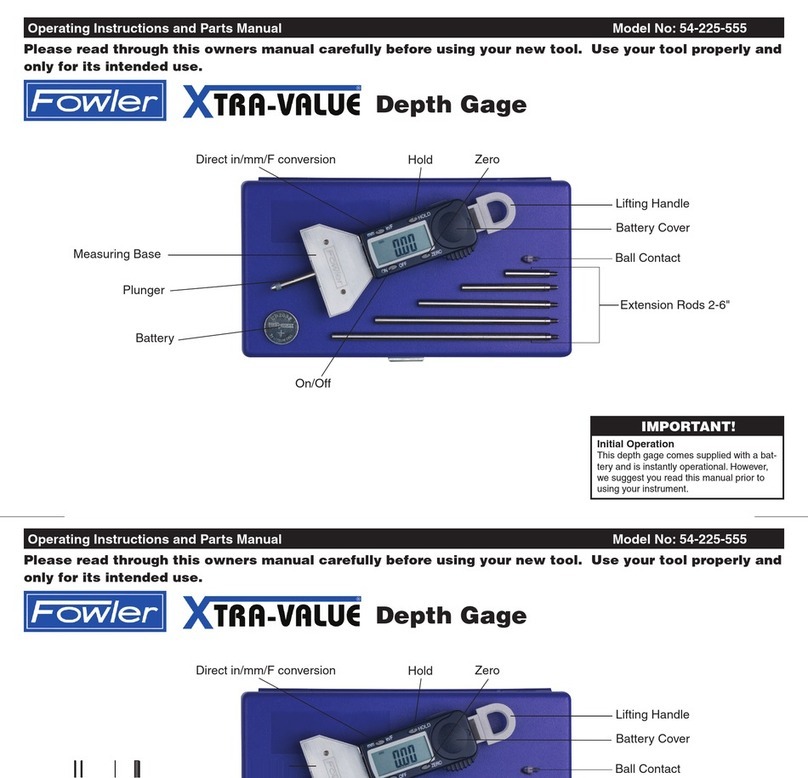
Fowler
Fowler 54-225-555 Operating instructions and parts manual
